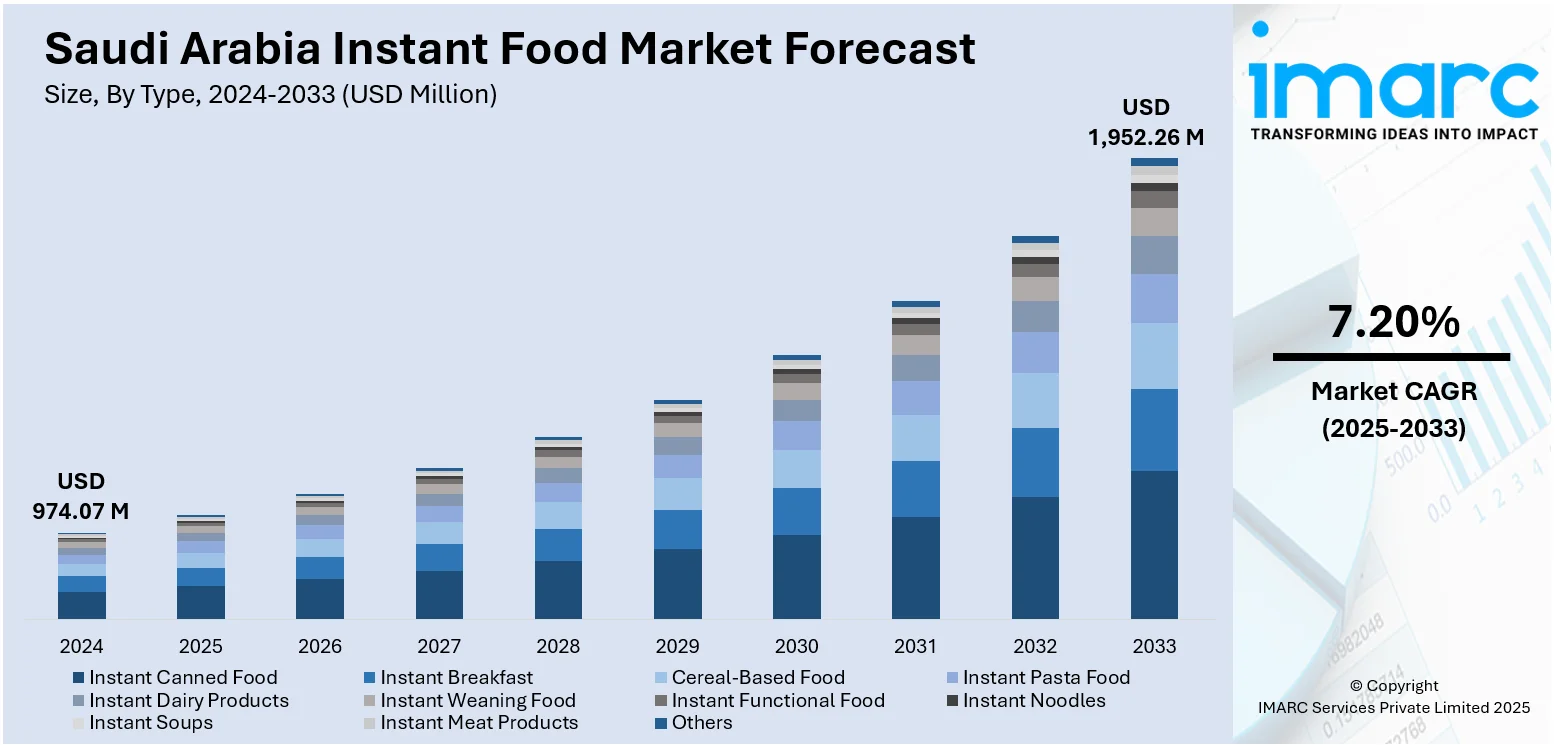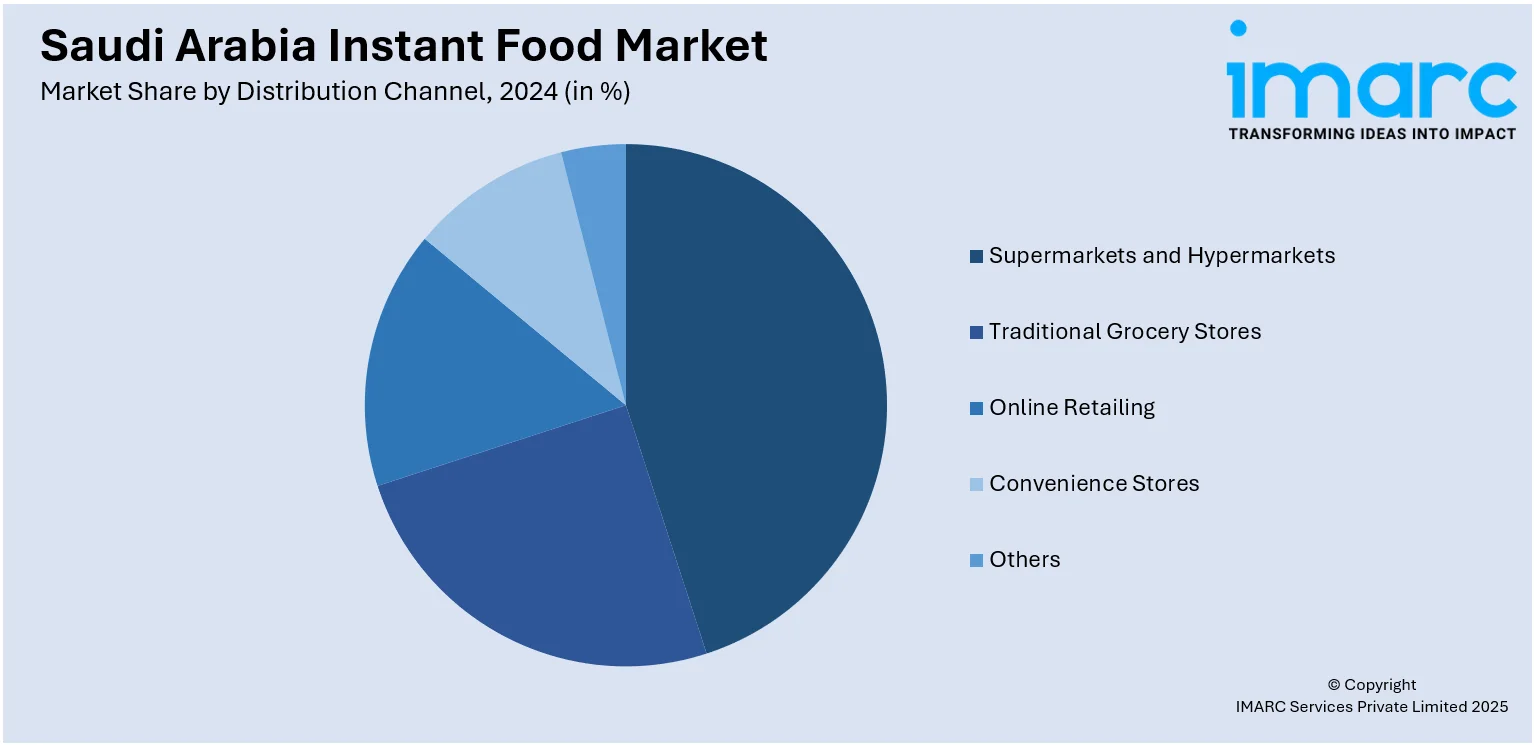
Saudi Arabia Instant Food Market Size, Share, Trends and Forecast by Type, Pack Size, Packaging Material, Diet Type, Distribution Channel, and Region, 2025-2033
Saudi Arabia Instant Food Market Overview:
The Saudi Arabia instant food market size reached USD 974.07 Million in 2024. Looking forward, IMARC Group expects the market to reach USD 1,952.26 Million by 2033, exhibiting a growth rate (CAGR) of 7.20% during 2025-2033. At present, the increasing changes in lifestyles with hectic working hours are impelling the growth of the market. Moreover, the extensive retail development and online platforms are contributing to the growth. Apart from this, the rise in product innovation and cultural fit that accommodates the preferences and dietary laws of the locals is expanding the Saudi Arabia instant food market share.
|
Report Attribute
|
Key Statistics
|
|---|---|
|
Base Year
|
2024 |
|
Forecast Years
|
2025-2033
|
|
Historical Years
|
2019-2024
|
| Market Size in 2024 | USD 974.07 Million |
| Market Forecast in 2033 | USD 1,952.26 Million |
| Market Growth Rate 2025-2033 | 7.20% |
Saudi Arabia Instant Food Market Trends:
Urbanization and Lifestyle Changes
The Saudi Arabian instant food industry is experiencing growth since the population is embracing faster lifestyles. More Saudi nationals and expatriates are migrating into urban centers like Riyadh, Jeddah, and Dammam, where hectic working hours and busy lifestyles are reducing the time to eat at home. Consumers are increasingly turning to instant food products like ready-to-eat meals, instant noodles, and frozen snacks since they take little preparation time and provide instant, dependable nutrition. This trend is being supported by the growing number of working women and young professionals who are balancing convenience without sacrificing taste. Information from the General Authority for Statistics (GASTAT) showed that the labor force participation rate of Saudi women hit 36.2 percent in the third quarter of 2024. This signified a rise of 0.8 percentage points from the last quarter, highlighting the expanding influence of women in the labor market. The government's Vision 2030 program is also driving more women into the labor market, driving the demand for time-saving food solutions.

To get more information on this market, Request Sample
Growth of Modern Retail and E-Commerce Channels
The extensive retail development and online platforms are contributing to Saudi Arabia instant food market growth. Saudi supermarkets, hypermarkets, and convenience stores are assigning increasing retail space to ready-to-eat meals, dry soups, and instant noodles as demand from consumers continues to rise. International and domestic instant food brands are being stocked by retail majors like Carrefour, Panda, and Lulu, which makes such items widely available. Additionally, online shopping platforms are leveraging the growing digital literacy and internet penetration in the Kingdom to deliver instant food items to consumers' doorsteps. This digital transition is being facilitated by enhanced logistics infrastructure, enabling even consumers in distant or secondary cities to buy instant food conveniently. With the increasing prevalence of online food shopping, particularly among the younger generation, the visibility and availability of instant food are rising. The IMARC Group predicts that the Saudi Arabia e-commerce market size is expected to increase to USD 708.7 Billion by 2033.
Cultural Adaptation and Innovation
The Saudi Arabia instant food industry is driven by a rise in product innovation and cultural fit that accommodates the preferences and dietary laws of the locals. Instant food producers are developing more products that cater to traditional Saudi flavors, halal certification, and regional food style preferences, hence targeting a broader customer base. Popular foods such as kabsa, samboosa, and lentil soups, Arabic-style, are increasingly available in ready-to-cook or ready-to-eat preparations, narrowing the convenience-culture gap. In addition, healthy innovations like low-sodium products, gluten-free instant meals, and foods with added nutrients are appealing to educated urban consumers looking for convenience and nutrients. These customized products are being served not just to Saudi nationals but also to the huge expatriate community from other countries who are seeking affordable versions of their local cuisine. Instant food companies, as brands continue to localize and innovate, consumer trust and trial rates are gradually building across groups.
Saudi Arabia Instant Food Market Segmentation:
IMARC Group provides an analysis of the key trends in each segment of the market, along with forecasts at the country and regional levels for 2025-2033. Our report has categorized the market based on type, pack size, packaging material, diet type, and distribution channel.
Type Insights:
- Instant Canned Food
- Instant Breakfast
- Cereal-Based Food
- Instant Pasta Food
- Instant Dairy Products
- Instant Weaning Food
- Instant Functional Food
- Instant Noodles
- Instant Soups
- Instant Meat Products
- Others
The report has provided a detailed breakup and analysis of the market based on the type. This includes instant canned food, instant breakfast, cereal-based food, instant pasta food, instant dairy products, instant weaning food, instant functional food, instant noodles, instant soups, instant meat products, and others.
Pack Size Insights:
- Single Pack
- Four Pack
- Six Pack
- Others
The report has provided a detailed breakup and analysis of the market based on the pack size. This includes single pack, four pack, six pack, and others.
Packaging Material Insights:
- Cardboard Boxes
- Pouches
- Plastic Cups
- Others
The report has provided a detailed breakup and analysis of the market based on the packaging material. This includes cardboard boxes, pouches, plastic cups, and others.
Diet Type Insights:
- Vegetarian
- Non-Veg
- Vegan
The report has provided a detailed breakup and analysis of the market based on the diet type. This includes vegetarian, non-veg, and vegan.
Distribution Channel Insights:

- Supermarkets and Hypermarkets
- Traditional Grocery Stores
- Online Retailing
- Convenience Stores
- Others
A detailed breakup and analysis of the market based on the distribution channel have also been provided in the report. This includes supermarkets and hypermarkets, traditional grocery stores, online retailing, convenience stores, and others.
Regional Insights:
- Northern and Central Region
- Western Region
- Eastern Region
- Southern Region
The report has also provided a comprehensive analysis of all the major regional markets, which include Northern and Central Region, Western Region, Eastern Region, and Southern Region.
Competitive Landscape:
The market research report has also provided a comprehensive analysis of the competitive landscape. Competitive analysis such as market structure, key player positioning, top winning strategies, competitive dashboard, and company evaluation quadrant has been covered in the report. Also, detailed profiles of all major companies have been provided.
Saudi Arabia Instant Food Market Report Coverage:
| Report Features | Details |
|---|---|
| Base Year of the Analysis | 2024 |
| Historical Period | 2019-2024 |
| Forecast Period | 2025-2033 |
| Units | Million USD |
| Scope of the Report |
Exploration of Historical Trends and Market Outlook, Industry Catalysts and Challenges, Segment-Wise Historical and Future Market Assessment:
|
| Types Covered | Instant Canned Food, Instant Breakfast, Cereal-Based Food, Instant Pasta Food, Instant Dairy Products, Instant Weaning Food, Instant Functional Food, Instant Noodles, Instant Soups, Instant Meat Products, Others |
| Pack Sizes Covered | Single Pack, Four Pack, Six Pack, Others |
| Packaging Materials Covered | Cardboard Boxes, Pouches, Plastic Cups, Others |
| Diet Types Covered | Vegetarian, Non-Veg, Vegan |
| Distribution Channels Covered | Supermarkets and Hypermarkets, Traditional Grocery Stores, Online Retailing, Convenience Stores, Others |
| Regions Covered | Northern and Central Region, Western Region, Eastern Region, Southern Region |
| Customization Scope | 10% Free Customization |
| Post-Sale Analyst Support | 10-12 Weeks |
| Delivery Format | PDF and Excel through Email (We can also provide the editable version of the report in PPT/Word format on special request) |
Key Questions Answered in This Report:
- How has the Saudi Arabia instant food market performed so far and how will it perform in the coming years?
- What is the breakup of the Saudi Arabia instant food market on the basis of type?
- What is the breakup of the Saudi Arabia instant food market on the basis of pack size?
- What is the breakup of the Saudi Arabia instant food market on the basis of packaging material?
- What is the breakup of the Saudi Arabia instant food market on the basis of diet type?
- What is the breakup of the Saudi Arabia instant food market on the basis of distribution channel?
- What is the breakup of the Saudi Arabia instant food market on the basis of region?
- What are the various stages in the value chain of the Saudi Arabia instant food market?
- What are the key driving factors and challenges in the Saudi Arabia instant food market?
- What is the structure of the Saudi Arabia instant food market and who are the key players?
- What is the degree of competition in the Saudi Arabia instant food market?
Key Benefits for Stakeholders:
- IMARC’s industry report offers a comprehensive quantitative analysis of various market segments, historical and current market trends, market forecasts, and dynamics of the Saudi Arabia instant food market from 2019-2033.
- The research report provides the latest information on the market drivers, challenges, and opportunities in the Saudi Arabia instant food market.
- Porter's five forces analysis assist stakeholders in assessing the impact of new entrants, competitive rivalry, supplier power, buyer power, and the threat of substitution. It helps stakeholders to analyze the level of competition within the Saudi Arabia instant food industry and its attractiveness.
- Competitive landscape allows stakeholders to understand their competitive environment and provides an insight into the current positions of key players in the market.
Need more help?
- Speak to our experienced analysts for insights on the current market scenarios.
- Include additional segments and countries to customize the report as per your requirement.
- Gain an unparalleled competitive advantage in your domain by understanding how to utilize the report and positively impacting your operations and revenue.
- For further assistance, please connect with our analysts.
 Request Customization
Request Customization
 Speak to an Analyst
Speak to an Analyst
 Request Brochure
Request Brochure
 Inquire Before Buying
Inquire Before Buying




.webp)




.webp)












